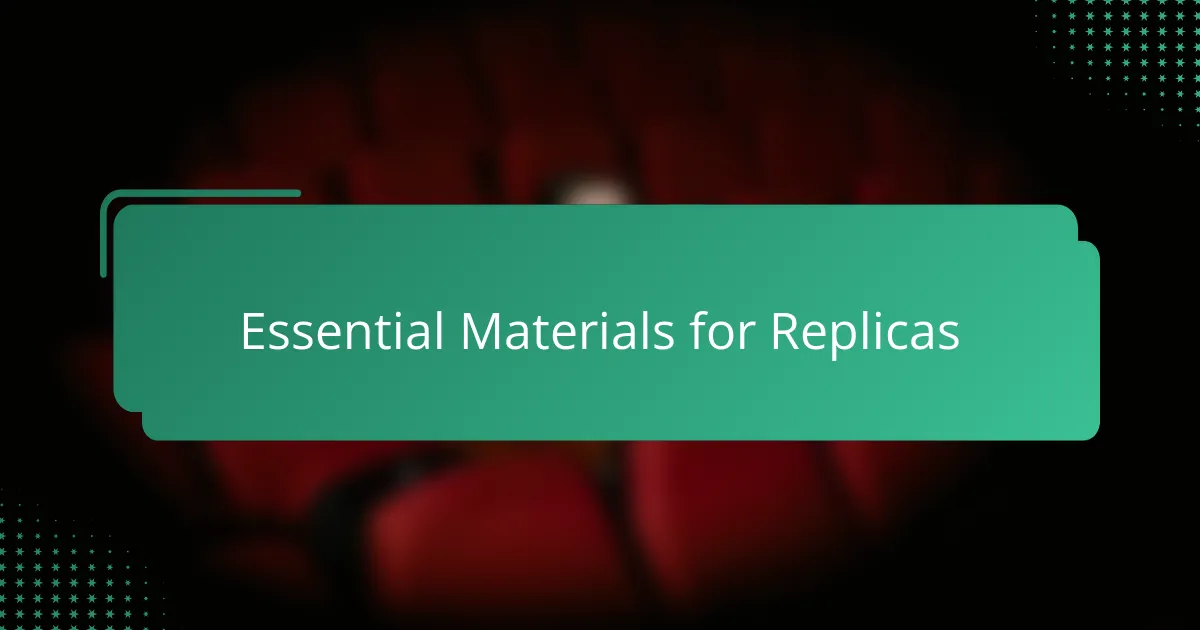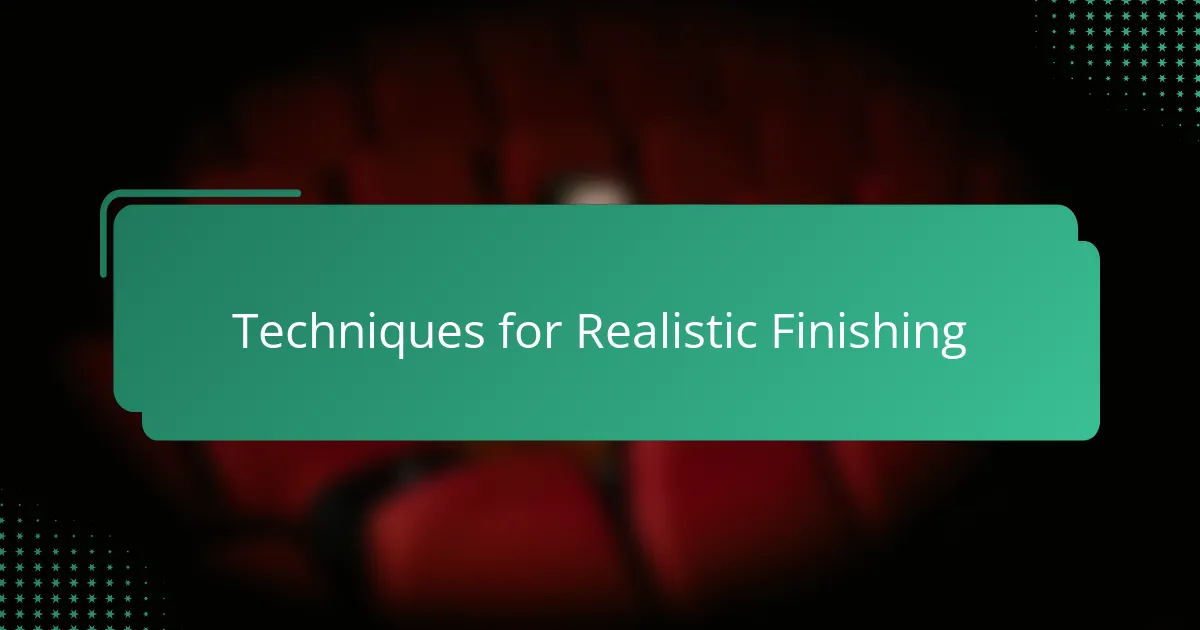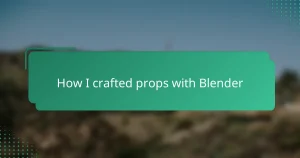Key takeaways
- Science fiction props serve as creative tools, connecting fans to their favorite universes and storylines.
- Selecting appropriate materials and using effective techniques are crucial to achieving realistic and detailed replicas.
- The prop-making process involves meticulous planning, crafting, and finishing to capture the essence of the original design.
- Sharing completed replicas with the community enhances the experience and fosters connections among fans.

Understanding Science Fiction Props
Science fiction props are more than just objects; they’re gateways to imagining futuristic worlds. Have you ever held a prop and felt instantly transported to another galaxy? That feeling always struck me as magical—like touching a piece of someone’s imagination made tangible.
Understanding these props means appreciating the blend of creativity and technology behind them. From sleek metallic finishes to intricate detailing, each element is designed to tell a story without words. I remember spending hours studying the textures and mechanics of my first replica—it felt like learning a new language.
What fascinates me most is how these props connect fans to their favorite universes on a personal level. They’re reminders of epic adventures and timeless characters. When I create replicas, I ask myself: How can I honor that emotional connection while staying true to the original design? This question drives every detail I craft.

Essential Materials for Replicas
When I first started building Star Wars replicas, I quickly realized that choosing the right materials was like picking the perfect ingredients for a recipe. Plastics like ABS and PVC were my go-to because they’re lightweight yet sturdy—just what you need to capture the sleek, futuristic look without feeling flimsy. Have you ever tried working with a material that just didn’t hold up? That frustration pushed me to experiment until I found what worked best.
Metal components added a satisfying weight and authenticity that I couldn’t ignore. I remember the first time I crafted a blaster prop with aluminum parts; holding it felt surprisingly real, almost like I had a piece of the Star Wars universe in my hands. It’s amazing how different materials can completely change the vibe of a replica—something as simple as using resin for intricate details really brings out the fine textures.
Of course, paint and weathering materials are essential for finishing touches. I ask myself, how do I make this prop look like it’s seen battles across galaxies? Using acrylic paints combined with weathering powders lets me add grime, burns, and wear that tell a story. These subtle details turn a good replica into a great one—and that’s what keeps me coming back for the next project.

Tools Required for Prop Making
Having the right tools at hand made all the difference when I embarked on building my Star Wars replicas. Cutting tools like precision knives and rotary tools became extensions of my hands, allowing me to shape materials exactly as I envisioned. Have you ever struggled with a dull blade? I quickly learned that sharpness wasn’t just a matter of convenience—it was essential for clean, accurate cuts.
Sanding and smoothing tools soon became my closest allies. Sandpaper in various grits and small rotary sanding bits helped me refine edges and achieve that flawless finish that makes a prop feel authentic. When I first sanded a blaster’s contour to perfection, the sense of satisfaction was like no other—I could almost see the prop stepping out of the screen.
Then there’s the whole world of adhesives and clamps. Choosing the right glue for different materials was a bit of a puzzle at first, but getting it right meant the difference between a fragile model and a sturdy piece ready for display. I still remember the relief of seeing my first fully assembled replica hold together flawlessly—it was a small victory that fueled my passion even more.

Step by Step Replication Process
The very first step I take is gathering precise reference images and measurements. Without this foundation, I often find myself guessing—and that’s when mistakes creep in. Have you ever tried building something intricate without a clear blueprint? Trust me, it only leads to frustration, so I make sure every detail lines up before cutting a single piece.
Next comes the careful crafting of each component, where patience truly pays off. I slice, shape, and assemble parts slowly, almost treating them like puzzle pieces that need to fit perfectly. Sometimes this means sanding down a stubborn edge multiple times; other times, it’s figuring out how to replicate tiny screws or vents. It’s tedious, yes, but that slow, deliberate work is what turns a prop from a mere model into something that feels alive.
Finally, the finishing touches make all the difference. I ask myself, how can I bring out the “lived-in” look that Star Wars props are known for? Layering paint, adding subtle weathering, and even tiny scratches tell a story through the prop’s surface. When I see that transformation happen, it’s like watching the replica step right off the screen — and that never gets old.

Techniques for Realistic Finishing
Getting that realistic finish is where the magic truly happens. I’ve found that layering paints rather than applying a single coat adds depth—each layer whispers a bit of history, like faint battle scars on a blaster. Have you ever noticed how something as simple as a subtle gradient or chipped paint can instantly convince your eyes that a prop has endured countless adventures?
When it comes to weathering, I’m a big fan of washes and dry brushing. Applying thin washes of dark color seeps into crevices, highlighting details you might not notice at first glance. Then, lightly dry brushing metallic or lighter tones gives edges that “worn but still functional” look. The first time I used this technique on a helmet replica, it felt like I could almost hear the hum of a distant starship—such a rewarding feeling.
I also can’t stress enough how important it is to step back and really study your work under different lighting. I’ve spent hours tweaking tiny imperfections only to discover that a bit of extra gloss or a matte finish transforms the whole piece. It makes me wonder: have you ever caught yourself adjusting a prop, trying to chase that perfect balance between authenticity and artistry? That’s the heart of realistic finishing for me.

Overcoming Challenges in Prop Creation
Challenges in prop creation are inevitable, but facing them head-on is where the real growth happens. I remember struggling with a tricky curve on a helmet replica that just wouldn’t align right. At first, frustration crept in, but pushing through and experimenting with different cutting techniques taught me the value of patience and persistence.
Sometimes materials don’t behave as expected—have you ever seen a perfect paint job crack because the base wasn’t properly prepped? That was a hard lesson for me early on. Now, I always test surfaces and plan each step carefully, knowing that small oversights can ripple into bigger problems later.
Glue and assembly presented their own hurdles too. Finding the right adhesive that held metal to plastic without any mess took trial and error. But when the pieces finally clicked together firmly and cleanly, that feeling of accomplishment reminded me why enduring the challenges is all worth it.

Sharing Personal Star Wars Replicas Experience
Working on Star Wars replicas has given me moments I’ll never forget—like the first time I held a perfectly finished blaster in my hands and felt an overwhelming connection to the saga. Have you ever experienced something so visceral from creating an object? For me, each replica is a part of my own journey through that galaxy far, far away.
There’s something special about sharing these creations with fellow fans, too. I recall bringing my latest helmet replica to a local fan meetup, watching their eyes light up as they examined the details closely. That exchange—the excitement, the shared passion—made all the late nights and challenges worth it. It reminded me that these props aren’t just collectibles; they’re bridges between people.
Sometimes, the process feels like an emotional rollercoaster. I’ve faced moments of doubt when a piece didn’t turn out as planned, questioning if I should start over. But then, with every correction and tweak, I see progress—and that resilience feels deeply rewarding. Isn’t that part of what makes crafting so personal and meaningful?


